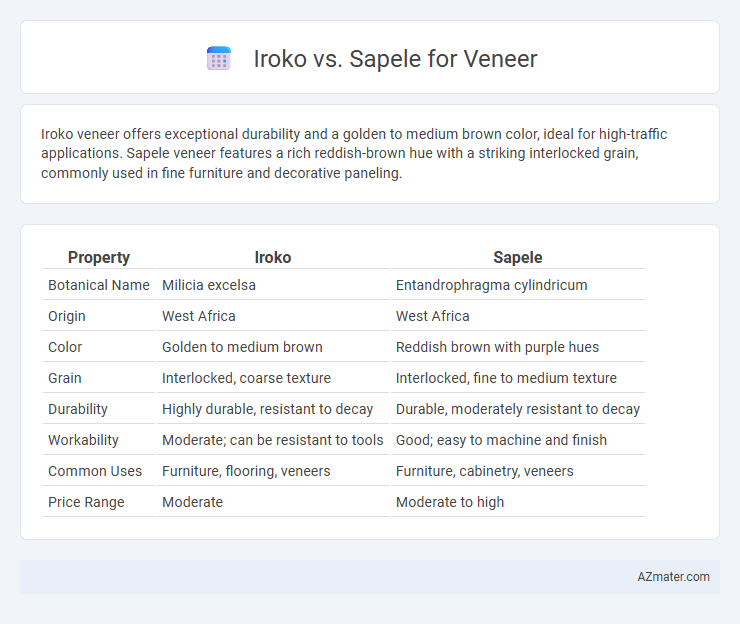Iroko veneer offers exceptional durability and a golden to medium brown color, ideal for high-traffic applications. Sapele veneer features a rich reddish-brown hue with a striking interlocked grain, commonly used in fine furniture and decorative paneling.
Table of Comparison
| Property | Iroko | Sapele |
|---|---|---|
| Botanical Name | Milicia excelsa | Entandrophragma cylindricum |
| Origin | West Africa | West Africa |
| Color | Golden to medium brown | Reddish brown with purple hues |
| Grain | Interlocked, coarse texture | Interlocked, fine to medium texture |
| Durability | Highly durable, resistant to decay | Durable, moderately resistant to decay |
| Workability | Moderate; can be resistant to tools | Good; easy to machine and finish |
| Common Uses | Furniture, flooring, veneers | Furniture, cabinetry, veneers |
| Price Range | Moderate | Moderate to high |
Introduction to Iroko and Sapele Veneers
Iroko veneer, derived from the durable African Iroko tree, is renowned for its golden to medium brown color with darker streaks, providing a robust and attractive finish ideal for furniture and cabinetry. Sapele veneer originates from the West African Sapele tree, featuring a rich reddish-brown hue with a subtle, interlocked grain pattern that enhances visual depth and texture in interior applications. Both veneers offer excellent stability and workability, making them popular choices for high-quality decorative surfaces.
Botanical Origins and Distribution
Iroko veneer is derived from Milicia excelsa, a hardwood tree native to West Africa's tropical forests, primarily found in countries like Nigeria, Ghana, and Cameroon. Sapele veneer comes from Entandrophragma cylindricum, a member of the mahogany family, widespread across tropical Africa, including regions such as the Congo Basin and Ivory Coast. Both species thrive in dense, humid environments, influencing their durability and grain characteristics in veneer applications.
Appearance and Grain Patterns
Iroko veneer exhibits a golden to medium brown color with interlocked, coarse grain patterns that create a visually textured surface, often highlighted by its natural luster. Sapele veneer features a rich reddish-brown hue with a distinctive ribbon-like grain pattern that produces a wavy, striped appearance, enhancing its decorative appeal. Both veneers offer unique visual textures, but Iroko presents a more fibrous and rugged look, while Sapele provides elegant, fine grain detailing ideal for sophisticated woodwork.
Durability and Hardness
Iroko veneer is known for its high durability, offering excellent resistance to decay and insect attacks, making it ideal for both indoor and outdoor applications. Sapele veneer, while also durable, is slightly less hard than Iroko, with a Janka hardness rating around 1700 compared to Iroko's approximate 1600-1700 range, providing a balance of strength and workability. Both veneers exhibit good stability, but Iroko's hardness and toughness make it superior for heavy-duty furniture and flooring projects.
Workability and Machinability
Iroko veneer offers excellent workability with its medium hardness and stable grain, making it easy to cut, shape, and glue without excessive wear on tools. Sapele veneer, while slightly harder than Iroko, provides good machinability but may require sharper blades to achieve clean cuts and prevent chipping due to its interlocked grain pattern. Both veneers respond well to sanding and finishing, but Iroko tends to deliver smoother surfaces more consistently in precision woodworking tasks.
Color Stability and Aging
Iroko veneer exhibits excellent color stability, maintaining its golden to medium brown hues over time with minimal darkening, making it ideal for projects requiring consistent appearance. Sapele veneer, while initially showing rich reddish-brown tones, tends to darken more noticeably and develop a deeper patina as it ages due to oxidation. Both veneers age gracefully, but Iroko's resistance to color changes enhances its appeal for long-term use in fine furniture and interior finishes.
Cost Comparison and Availability
Iroko veneer typically costs more than Sapele due to its greater durability and richer grain patterns, making it a preferred choice for high-end furniture and cabinetry. Sapele, more abundant and widely harvested in West Africa, offers a more affordable veneer option with attractive reddish-brown hues and good workability. Availability of Sapele veneer remains consistent in the global market, while Iroko supplies can be limited and subject to stricter export regulations, impacting its price and accessibility.
Environmental Sustainability
Iroko veneer, sourced from African Iroko trees, is prized for its durability and resistance to pests, but concerns about sustainable harvesting practices impact its environmental footprint. Sapele veneer, derived from sustainably managed forests in West Africa, often benefits from certification schemes like FSC, promoting responsible forestry and reduced ecological damage. Choosing sustainably sourced Sapele veneer supports biodiversity conservation and lower carbon emissions compared to uncertified Iroko alternatives.
Applications in Furniture and Interior Design
Iroko veneer, known for its durability and golden to medium brown hues, is widely utilized in furniture making and interior design for creating robust and visually appealing surfaces. Sapele veneer offers a rich reddish-brown tone with a fine texture, making it popular for decorative paneling, cabinetry, and high-end furniture that requires a luxurious finish. Both veneers are favored for their stability and resistance to wear, enhancing the longevity and aesthetic value of interior furnishings.
Choosing the Right Veneer: Iroko vs Sapele
Iroko veneer offers exceptional durability and a golden to medium brown color with distinct grain patterns, making it ideal for heavy-use furniture and flooring. Sapele veneer features a rich reddish-brown hue with a fine, interlocking grain that enhances aesthetics for cabinetry and decorative panels. Selecting between Iroko and Sapele veneers depends on the desired balance between robustness and visual warmth for your interior design project.

Infographic: Iroko vs Sapele for Veneer
 azmater.com
azmater.com